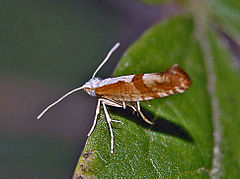| Cherry blossom tineid | |
|---|---|

| |
| Argyresthia pruniella. Side view | |

| |
| Dorsal view | |
| Scientific classification | |
| Domain: | Eukaryota |
| Kingdom: | Animalia |
| Phylum: | Arthropoda |
| Class: | Insecta |
| Order: | Lepidoptera |
| Family: | Argyresthiidae |
| Genus: | Argyresthia |
| Species: | A. pruniella |
| Binomial name | |
| Argyresthia pruniella Clerck, 1759 | |
| Synonyms | |
| |
Argyresthia pruniella, the cherry fruit moth or cherry blossom tineid, is a moth from the family Yponomeutidae, the ermine moths.
Description
Argyresthia pruniella has a wingspan of 10–13 millimetres (0.39–0.51 in). Forewings are reddish-brown with a white dorsal stripe and a dark transversal brown stripe in the middle. Antennae are white with brown bands. Along the forewings lower edge there is a row of white spots. Hindwings are brownish and very narrow, with very long fringes. The caterpillars are pale green with a brown head.
Biology
Larvae are oligophagous. Main host plants are apple, apricot, cherry, peach, plum, pear and hazel. The larva lives in the shoots. The flight time ranges from early July to late August. These moths are attracted to light. They are considered a pest of the cultures of said plants.
Distribution
This species can be found in most of Europe, in Asia Minor and in North America.
Gallery
References
- Biolib
- ^ UK Moths
- ^ Microlepidoptera Archived December 22, 2015, at the Wayback Machine
- ^ Agro Atlas
- Heath, J. ed. 1996 The Moths and Butterflies of Great Britain and IrelandVolume 3 (Yponomeutidae to Elachistidae)
- Fauna Europaea
- Funet
External links
| Taxon identifiers | |
|---|---|
| Argyresthia pruniella |
|
This article on a moth of the family Yponomeutidae is a stub. You can help Misplaced Pages by expanding it. |


